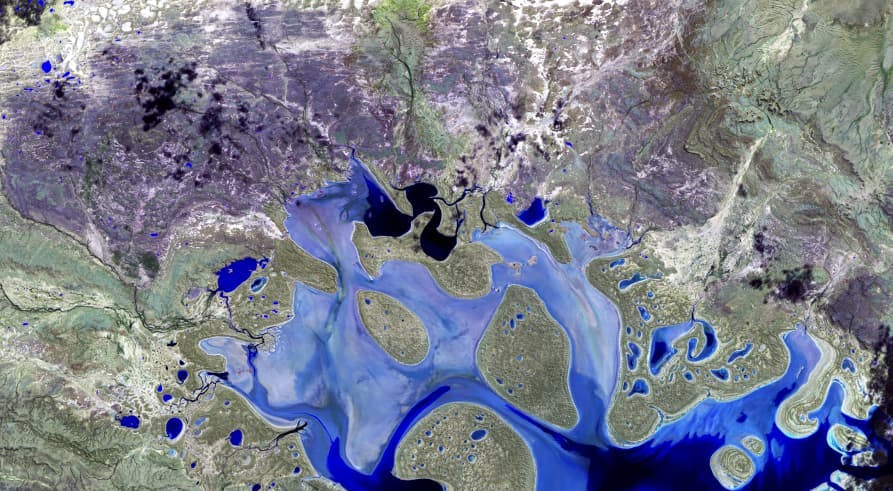ESG / CSR
Industries
Why is the Launch of NASA’s PACE Satellite Important?



Technology and advancements in the space industry, such as with the new PACE satellite by NASA, have not only allowed us to search for obscure elements such as UFOs, but to help us one of our greatest battles here on Earth – otherwise known as climate change.
NASA’s PACE satellite was made to help study ocean health and the overall climate, but why is this launch of this satellite more pivotal than previous ones?
In this article, we’ll talk about NASA’s PACE satellite, its main mission, how the PACE satellite will work, and if the PACE satellite can be adjusted to prove even more effective moving forward.
What is NASA’s PACE satellite?
NASA’s PACE satellite, where PACE Plankton, Aerosol, Climate, ocean Ecosystem, is a new satellite which will work to provide us a better understanding of our planet’s current health and climate dynamics.
A few more hallmark features of NASA’s new PACE satellite include:
- Global monitorization of the ocean;
- Use of a new Ocean Color Instrument (OCI);
- Measures the relationship between sunlight and seawater;
- Monitors microscopic marine life such as plankton;
- Multiangle polarimeters (MAP) to measure cloud patterns and behaviors;
- Hyper-Angular Rainbow Polarimeter (HARP) to determine polarization patterns from aerosol particles and how they impact our air quality;
- Laser Retroreflector Array (LRA) which will allow the PACE satellite to collect precise measurements.
Having officially been launched as of February 2024, the PACE satellite will work to provide worldwide coverage of the our oceans and atmospheres – and subsequently bring forth new information regarding our carbon update, ocean health, and the impact of aerosols on cloud activity. As a result, the PACE satellite will help us to learn more about what the IPCC has already confirmed – which is that increased human activity is one of the main reasons behind the rising threat of climate change.
👉 The launch of the new PACE satellite is monumental as it incorporates the use of never-before used technologies to monitor our planet on a continuous and multidimensional level – which could prove useful for scientists, lawmakers, and even the development of future satellites.

What is the main mission of NASA’s PACE satellite?
The main goal of the new PACE satellite is to observe the interactions between Earth’s various systems – predominantly between the ocean and our atmosphere, and how they impact climate change.
In addition to helping us to better understand how human activities have had a profound impact on our oceans and atmospheric conditions, the PACE satellite will support the Biden-Harris administration’s climate agenda – which has made an exceptional effort to expand the use of clean energy and create climate jobs.
As the PACE satellite will provide new, in-depth information regarding the current state of our climate – it may incentivize countries like the U.S. to move forward with clean energy projects and ultimately support the Biden-Harris climate agenda.
Additional goals of NASA’s new PACE satellite include working to collect and analyze data on:
- Air quality and air pollution
- General atmospheric conditions
- Cloud properties
- Understand our carbon cycle
- Marine life ecosystems and environmental changes
- Oceanography and water current patterns
👉 Ultimately, what makes the main goal of NASA’s PACE satellite not only special, but achievable – is how it’s multi-functional set-up will allow us to understand interrelated areas of our environment and how they have contributed to climate change.

How will NASA’s PACE satellite work?
NASA’s PACE satellite will work by making use of three specific instruments designed to collect data and sounds related to our ocean and clouds, with all of these sensors working together to allow for maximum data collection and future analysis.
The four main instruments that are included in the PACE satellite include:
- Ocean Color Instrument (OCI) – The PACE satellite will use this instrument to detect color pigments in the ocean with the use of a 360° revolving telescope, two hyperspectral spectrographs, and a thermal radiator. The OCI will be able to measure more than 200 different kinds of colors!
- Multi-Angle Polarimeters (MAP) – This instrument will be used by the PACE satellite to measure atmospheric patterns, such as with cloud or aerosol particle behaviors and how they affect AQI index.
- Laser Retroreflector Array (LRA) – This component of the PACE satellite is used to measure the time of laser pulses, which ultimately – helps to determine the satellite’s current location and ensure the most precise data collection possible. This is a passive method to tracking a satellite, which works well for the PACE satellite – as it seeks to collect round-the-clock information around the world.
- Hyper-Angular Rainbow Polarimeter (HARP) – Lastly, this specialized piece used by the PACE satellite HARP works to measure the polarization of sunlight by atmospheric aerosols. This is done by observing the distribution of light from precise angles. This can help scientists to better understand how our current air quality may compromise our health, and allow regulations to be developed in line with these scientific findings.
As these sensors and instruments work together, the PACE satellite will be able to scan our planet every 48 hours – allowing for vast and varied data collection. In addition to this, the polarimeters installed into the PACE satellite will allow for real-time monitoring of our current levels of air pollution.
👉 The PACE satellite will work on a continuous basis to monitor the oceanic and atmospheric conditions across our planet with the help of multiple sensors each designed to allow for meticulous data collection.

How is NASA’s PACE satellite different from other satellites?
NASA's PACE satellite differs from other satellites as it is specifically designed to help monitor the planet’s oceans and atmospheres, whereas other “environmentally focused” satellites such as GOSAT work specifically to view greenhouse gas emissions on Earth from space.
💡Ultimately, the PACE satellite can provide us with a deeper understanding and newfound insight to help protect our oceans and influence actions against further climate change accordingly.
Here are a few more ways in which PACE is different from other satellites:
- New Focus Areas– Several satellites work to monitor our oceans, but PACE can go one step beyond those satellites – with the ability to focus on small marine life, clouds, ocean colors, and more. This specific monetization can help us to learn more about overall ocean health and assist us in developing future climate legislation.
- Specialized Instrumentation – PACE is equipped with advanced technologies, such as an Ocean Color Instrument (OCI) that can help us to quantify and qualify ocean colors. Overall, these unique instruments set the PACE satellite apart from others, as it can help scientists to better understand the inner-workings of the ocean – most of which still remains vast and unknown to mankind.
- Worldwide Coverage – Most satellites are set up to monitor a specific area, such as the satellites installed for Google Maps – but the PACE satellite is working overtime all around the world. This is because the PACE satellite has access to oceans across the globe, which can provide substantial amounts of information to better understand ocean circulation and other relevant climate effects.
- Multi-Tasking Capabilities – The PACE satellite is able to compute data across the board, such as from biology, atmospheric data, and ocean data. The ability to understand and compute information from these varying sources means that the PACE satellite can provide us with a more complex understanding of our environmental impact.
- Long-Term Functionality – The PACE satellite is here to stay, with NASA’s latest creation having been made to track changes in ocean life, currents, and atmospheric conditions over the long-run. This means that the PACE satellite will be able to determine if our human activities are continuing to create a negative impact on the ocean and its environment.
👉 One of the first satellites that may come to mind when comparing the two satellites is GOSAT, which differs from NASA’s PACE satellite as GOSAT seeks to measure GHG emissions while the PACE satellite is more concerned with the negative impacts climate change has had on oceanography and atmospheric conditions. However, both satellites can help us to learn more about how climate change is affecting our planet and act accordingly to rectify the issues we view from space.

Can NASA’s PACE satellite be improved?
As of now, the PACE satellite is equipped with up-to-date and state-of-the-art instruments which make it unlike any other satellite to enter orbit before – there are no immediate improvements to be made for the PACE satellite.
Here are some areas that designers and developers should keep in mind for the PACE satellite in the future:
- Merging Data From Other Satellites – The PACE satellite is equipped with many tools, but that doesn’t mean it couldn’t benefit from data being collected from other satellites. Therefore, finding a way to configure the data between one or more satellites with the PACE satellite could allow for enchanted data collection and analysis.
- Potentiality for Space Junk – Since the PACE satellite is configured with numerous instruments and specialized sensors, it leaves the satellite a cause for concern in terms of space junk – otherwise debris that may be get lost in outer space and impact our already vulnerable atmosphere.
- Measuring the Impact of the Satellite – The PACE satellite is expected to be a groundbreaking satellite to help NASA better understand our carbon cycle, environment, and the impact of climate change – but what about the impact it will have on people? Law makers and scientists alike should seek to measure if the environmental regulations or protocols to arise from the data provided by the PACE satellite will help to make a tangible difference in saving lives or protecting vulnerable marine ecosystems.
💡 However, one of the best improvements which could arise from the official launch of NASA’s new PACE satellite – is how it may inspire improvements to existing or future satellites. This is because the PACE satellite illustrates how a multi-functional satellite, able to monitor more than one facet of our environment on a global scale, is more than possible.
Ultimately, the launch of NASA’s PACE satellite is monumental as it is the first ever satellite which will provide us with novel and detailed information on how the ocean and atmosphere cope with excess levels of carbon dioxide in the air – with the opportunity to elicit real change in the fight against climate change elsewhere!
What About Greenly?
If reading this article about why NASA’s PACE satellite launch is important has made you interested in reducing your carbon emissions to further fight against climate change – Greenly can help you!
At Greenly we can help you to assess your company’s carbon footprint, and then give you the tools you need to cut down on emissions. We offer a free demo for you to better understand our platform and all that it has to offer – including assistance with boosting supplier engagement, personalized assistance, and new ways to involve your employees.
Click here to learn more about Greenly and how we can help you reduce your carbon footprint.




